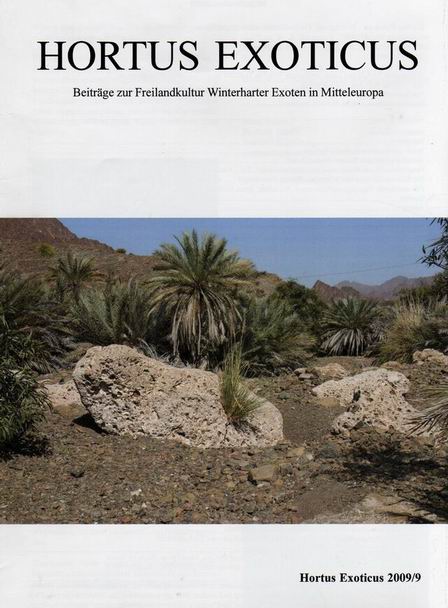|
Hortus Exoticus,
Heft 2009/9
Inhalt - Schlüsselwörter |
Zurück
zum Index |
Notro - der Feuerbusch,
J. Bredow
Abstract: Embothrium coccineum J. R. Forst. & G. Forst., one of the
most beautiful flowering exotic plants from Southern America, was said to
be not hardy enough in Central Europe. But some specimen are thriving well
und flowering regularly for many years in gardens. This article deals with
successfully grown specimens, their selection, planting and maintenance.
General botanical and phytoecological information is provided, too. - With
10 figures.
Keywords: Embothrium coccineum - hardiness - maintenance - selection
- suitability for Central European climate
Was sind winterharte Exoten? M. Lorek
Abstract: The terms “exotic plants” and “hardiness”
concerning Central European gardens are discussed. - With 3 figures.
Keywords: Central European climate - exotic plants - hardiness
Panaschierte Yuccas für den mitteleuropäischen Garten, Teil
I, A. Heim, T. Boeuf & S. Weissbeck
Abstract: Together with information on morphological characters, this
article provides a list of variegated Yuccas suitable for Central European
gardens. - In two parts, with 45 figures and 1 table.
Keywords: variegated Yucca - Yucca aloifolia - Yucca filamentosa - Yucca
flaccida - Yucca gloriosa - Yucca recurvifolia
Der Palmenwald von Elche in Spanien, T. Amersberger
Abstract: The Palmeral of Elche (Spain) represents the largest planting
of Phoenix dactylifera L. in Europe. It displays both, an unique palm vegetation
and a historic human heritage site, dating back some 2500–3000 years
and presenting a palm grove with very peculiar characteristics regarding
practices, pests, uses and socio-economic context. Although the climate is
generally not suited for date production that requires much higher temperatures,
the mild Mediterranean climate and the use of Phoenix hybrids offer factors
for a sufficient economic use. The Palmeral shows a large diversity due to
being bred over a very long time. - With 6 figures.
Keywords: El Palmeral - Elche - Phoenix dactylifera
Pflanzenporträt Tragopogon (Asteraceae) - Bocksbart, I.
Richter
Abstract: The genus Tragopogon contains some interesting overlooked species
for exotic garden design. Though, some species are neophytes or growing naturally
in Central Europe, they make a fine display in architectural gardening. The
best and hardiest species are treated with descriptions and hints for growing.
- With 2 figures.
Keywords: architectural design - exotic garden - Tragopogon dubius -
Tragopogon mirus - Tragopogon miscellus - Tragopogon pratensis
|

|
|
|
|
|